http://www.egyptology.com/niankhkhnum
Todavía no hay ninguna noticia de los estudios realizados con el AND de las dos momias de Nekht-Ankh y Nknum-Naknt,
Según un informe en el que se recogen as investigaciones realizadas con los dos cuerpos, se observa que Khum-Naknt murió a mediana edad, padecia de pleuresía y era de raza negra.
La momia de Nekht-Ankh, está mejor conservada y por la estructura de su cuerpo ,indican que fue un eunuco. Murió a los 60 años de edad , mas o menos. Y no pertenece a la raza negra.
Si realmente fueron hermanos, cosa que demostrarán las pruebas de ADN, pueden ser hijos de la misma madre y haber tenido padres distintos, o quizás hubo una adopción, o simplemente eran amantes.
cuelgo el enlace donde esta la información sobre las momias
y cuelgo el artículo con las fotos de la recontrucción de las caras etc..
http://www.ancient-egypt.co.uk/index.htm
The
Two
Brothers
Discovered by Flinders Petrie and the British School of Archaeology in 1907 at Rifeh in Middle Egypt.
--------------------------------------------------------------------------------
The tomb of the two brothers, Khnum-Nakht and Nekht-Ankh, was discovered by a workman called Erfai, working under the supervision of British Egyptologist Ernest Mackay in the course of official excavations directed by Sir William Flinders Petrie (1852-1942), within the British School of Archaeology.
The contents of the burial site were passed to the Manchester Museum where they were studied by Margaret Murray (1908) and more recently by Prof. Rosalie David (1979). The two brothers came from Der Rifeh in Middle Egypt and originate from the 12th Dynasty (c.1985-1773 BC).
Their burial was the finest non-royal tomb found in that area.
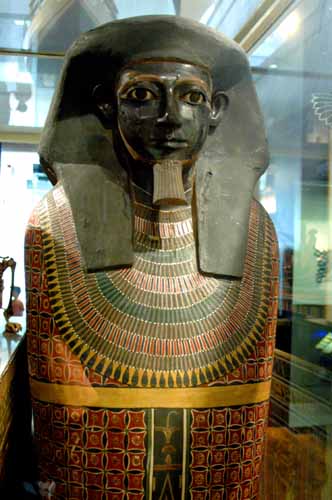
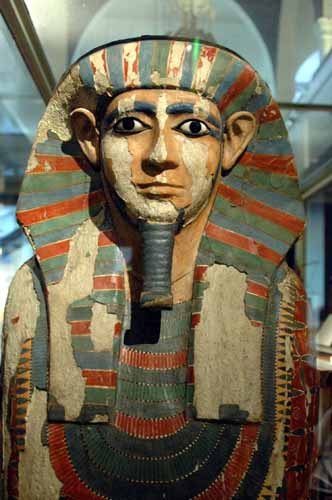
Según un informe en el que se recogen as investigaciones realizadas con los dos cuerpos, se observa que Khum-Naknt murió a mediana edad, padecia de pleuresía y era de raza negra.
La momia de Nekht-Ankh, está mejor conservada y por la estructura de su cuerpo ,indican que fue un eunuco. Murió a los 60 años de edad , mas o menos. Y no pertenece a la raza negra.
Si realmente fueron hermanos, cosa que demostrarán las pruebas de ADN, pueden ser hijos de la misma madre y haber tenido padres distintos, o quizás hubo una adopción, o simplemente eran amantes.
cuelgo el enlace donde esta la información sobre las momias
y cuelgo el artículo con las fotos de la recontrucción de las caras etc..
http://www.ancient-egypt.co.uk/index.htm
The
Two
Brothers
Discovered by Flinders Petrie and the British School of Archaeology in 1907 at Rifeh in Middle Egypt.
--------------------------------------------------------------------------------
The tomb of the two brothers, Khnum-Nakht and Nekht-Ankh, was discovered by a workman called Erfai, working under the supervision of British Egyptologist Ernest Mackay in the course of official excavations directed by Sir William Flinders Petrie (1852-1942), within the British School of Archaeology.
The contents of the burial site were passed to the Manchester Museum where they were studied by Margaret Murray (1908) and more recently by Prof. Rosalie David (1979). The two brothers came from Der Rifeh in Middle Egypt and originate from the 12th Dynasty (c.1985-1773 BC).
Their burial was the finest non-royal tomb found in that area.


Left - Body coffin of Khnum-Nakht. Wooden coffin held the body of the Negroid brother. The eyes of limestone and obsidian are inserted in a bronze rim.
Right - body coffin of Nekht-Ankh. Coffin has a face which is painted black, although it held the remains of the non-Negroid brother.
Unwrapping the 'Two Brothers'
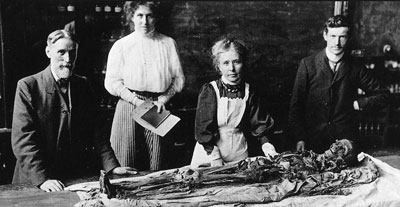
Both Professor Flinders Petrie and Dr. Margaret Murray, the first Egyptologist at the Manchester Museum, were convinced that only by continued study of the objects, which included the mummies themselves, would the efforts of archaeologists be enhanced. So in 1908, in a large lecture theatre in Manchester University before a capacity audience, Dr. Margaret Murray unwrapped the mummies of the 'Two Brothers'. This was an important development in scientific investigation, for it involved a multi-disciplinary team. These specialists - in the fields of anatomy, chemistry and textiles - subsequently carried out a full-scale investigation of the mummies.
There is comparatively little evidence of mummification from the Middle Kingdom (c.1900 BC) and the bodies that have been examined show that there was generally less painstaking preparation than in the Old Kingdom. The internal organs were removed, but less attention was given to the preservation of the body. Usually a thin cost of resin was applied to the skin surface, and this left the drying out of the body incomplete, so that decomposition soon set in. Although great care was often lavished on the outward appearance of the mummies, inside there is usually only a jumble of bones with little or no evidence of soft tissue.
The mummies of the 'Two Brothers' are particularly interesting because the difference in their condition is very striking. At the tine of unwrapping, the mummy of Khnum-Nakht was absolutely dry, whereas the remains of Nekht-Ankh were quite moist and most of the bandages were wet.
Khnum-Nakht
The mummy of Khnum-Nakht is a good example of the poor standard of preservation achieved in the Middle Kingdom. There was very little remaining skin tissue and most of the remnants resolved into a fine powder at the unwrapping. Also, no special care had been taken to preserve his nails.
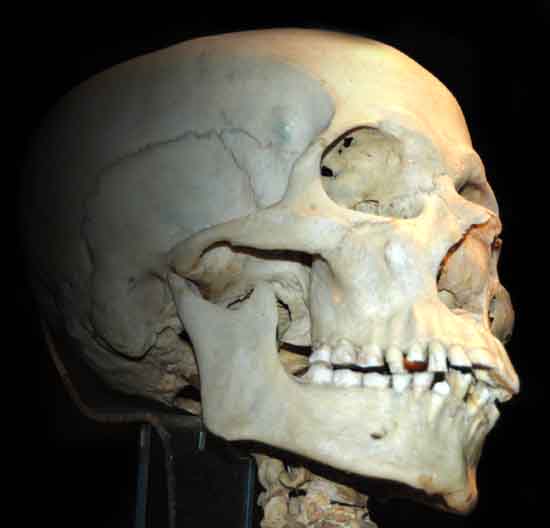
At the original investigation Khnum-Nakht was alleged to have a deformity of the left foot, with skin and tissue thickening indicating a clubfoot (talipes varus). Later radiological studies have not revealed any evidence of arthritis or secondary bone change in the foot which might have been anticipated in a long-standing congenital deformity. The present study supports the theory that the findings are due to excessively tight bandaging after death rather than to a clubfoot.
Khnum-Nakht's spine shows evidence of long-standing arthritis with abnormal curvature (scoliosis) in the thoracic region. Inspection of the teeth has revealed an extremely rare developmental abnormality - double gemination (fusion of the teeth); the two central teeth are abnormally large and the left one has two roots.
Skeleton of Khnum-Nakht shows he probably reached early middle-age and that the skull is negroid. There is almost a complete lack of similarity between this skeleton and his bother's. His teeth have a double gemination (fusion of the teeth), the two central teeth are abnormally large and the left one has two roots.
Nekht-Ankh
The mummy of Nekht-Ankh was better preserved, although the body had fallen to pieces before unwrapping, the bones were intact and in position. Even some hair remained, and the embalmers had wrapped the nails of the fingers and toes with thread to prevent their loss during the process of mummification. The appearance presented by this skeleton is suggestive of its being a eunuch, aged about sixty at time of death. Only Nekht-Ankh had a set of canopic jars and only two jars in the set had contents. These were identified as the liver with the gall bladder attached, and lung tissue to which adhered part of the wall of the heart. Examination revealed that Nekht-Ankh had suffered from pleurisy, and also from sand pneumoconiosis which may have been responsible for his death.
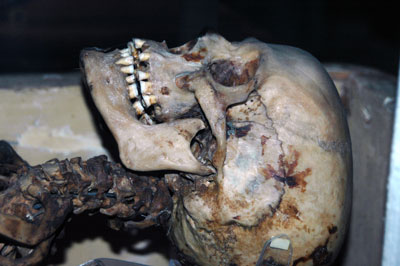
The report into the anatomical finding begins with the observation that there was a "remarkable racial difference in the features presented by each. These differences are so pronounced that it is almost impossible to convince oneself that they belong to the same race, far less to the same family. The appearance presented by the skeleton of Nekht-Ankh is suggestive of its being a eunuch. On first inspection of the bones at this skeleton the writer was much struck with their slimness, delicate moulding, and the faintness of the muscular impressions; indeed, their female character proved to be so pronounced that at first it was difficult to be sure that the skeleton was really that of a male. The pelvis was reunited and proved to have all the characteristics of a male".
When the two skulls were re-examined in the 1970s, with the help numerous radiological photographs it was found that there was almost a total anatomical difference between the features of the two.
Right - body coffin of Nekht-Ankh. Coffin has a face which is painted black, although it held the remains of the non-Negroid brother.
Unwrapping the 'Two Brothers'

Both Professor Flinders Petrie and Dr. Margaret Murray, the first Egyptologist at the Manchester Museum, were convinced that only by continued study of the objects, which included the mummies themselves, would the efforts of archaeologists be enhanced. So in 1908, in a large lecture theatre in Manchester University before a capacity audience, Dr. Margaret Murray unwrapped the mummies of the 'Two Brothers'. This was an important development in scientific investigation, for it involved a multi-disciplinary team. These specialists - in the fields of anatomy, chemistry and textiles - subsequently carried out a full-scale investigation of the mummies.
There is comparatively little evidence of mummification from the Middle Kingdom (c.1900 BC) and the bodies that have been examined show that there was generally less painstaking preparation than in the Old Kingdom. The internal organs were removed, but less attention was given to the preservation of the body. Usually a thin cost of resin was applied to the skin surface, and this left the drying out of the body incomplete, so that decomposition soon set in. Although great care was often lavished on the outward appearance of the mummies, inside there is usually only a jumble of bones with little or no evidence of soft tissue.
The mummies of the 'Two Brothers' are particularly interesting because the difference in their condition is very striking. At the tine of unwrapping, the mummy of Khnum-Nakht was absolutely dry, whereas the remains of Nekht-Ankh were quite moist and most of the bandages were wet.
Khnum-Nakht
The mummy of Khnum-Nakht is a good example of the poor standard of preservation achieved in the Middle Kingdom. There was very little remaining skin tissue and most of the remnants resolved into a fine powder at the unwrapping. Also, no special care had been taken to preserve his nails.

At the original investigation Khnum-Nakht was alleged to have a deformity of the left foot, with skin and tissue thickening indicating a clubfoot (talipes varus). Later radiological studies have not revealed any evidence of arthritis or secondary bone change in the foot which might have been anticipated in a long-standing congenital deformity. The present study supports the theory that the findings are due to excessively tight bandaging after death rather than to a clubfoot.
Khnum-Nakht's spine shows evidence of long-standing arthritis with abnormal curvature (scoliosis) in the thoracic region. Inspection of the teeth has revealed an extremely rare developmental abnormality - double gemination (fusion of the teeth); the two central teeth are abnormally large and the left one has two roots.
Skeleton of Khnum-Nakht shows he probably reached early middle-age and that the skull is negroid. There is almost a complete lack of similarity between this skeleton and his bother's. His teeth have a double gemination (fusion of the teeth), the two central teeth are abnormally large and the left one has two roots.
Nekht-Ankh
The mummy of Nekht-Ankh was better preserved, although the body had fallen to pieces before unwrapping, the bones were intact and in position. Even some hair remained, and the embalmers had wrapped the nails of the fingers and toes with thread to prevent their loss during the process of mummification. The appearance presented by this skeleton is suggestive of its being a eunuch, aged about sixty at time of death. Only Nekht-Ankh had a set of canopic jars and only two jars in the set had contents. These were identified as the liver with the gall bladder attached, and lung tissue to which adhered part of the wall of the heart. Examination revealed that Nekht-Ankh had suffered from pleurisy, and also from sand pneumoconiosis which may have been responsible for his death.

The report into the anatomical finding begins with the observation that there was a "remarkable racial difference in the features presented by each. These differences are so pronounced that it is almost impossible to convince oneself that they belong to the same race, far less to the same family. The appearance presented by the skeleton of Nekht-Ankh is suggestive of its being a eunuch. On first inspection of the bones at this skeleton the writer was much struck with their slimness, delicate moulding, and the faintness of the muscular impressions; indeed, their female character proved to be so pronounced that at first it was difficult to be sure that the skeleton was really that of a male. The pelvis was reunited and proved to have all the characteristics of a male".
When the two skulls were re-examined in the 1970s, with the help numerous radiological photographs it was found that there was almost a total anatomical difference between the features of the two.
The inscriptions on the coffins states that Khnum-Nakht was a 'Great Waab-priest' of the local god Khnum and both his father and grandfather bore the title of local mayor - although nether is named. The inscriptions referring to Nekht-Ankh are rather different. He is referred as the son of an unnamed local major but his paternal grandfather is not mentioned. However, the men were sons of the same woman. Aa-Khnumu, who was an heiress of landed property?
This slight variation in the inscriptions, taken in conjunction with the men's marked anatomical differences, may indicate that their mother had two husbands, and that the father of Khnum-Nakht possessed Nubian ancestry. During much of Egypt's history, there was a certain mingling of the peoples of Nubia with those of Egypt at all levels of society. However, it is accepted nowadays that a child may well inherit a marked similarity to one of his parents while having no resemblance at all to the other. This could well be the case with the two brothers, and one had the usual appearance of an Egyptian while the other had inherited the characteristic Nubian features.
Another possibility, and equally likely explanation of this difference in appearance, is that Nekht-Ankh was adopted into the family at a very early age, and having been a member of it for so many years, had become accepted as the son of Aa-Khnumu. Future DNA studies on samples of tissues or bone taken from these bodies may provide an answer to the question of their relationship. Professor Rosalie David (OBE, FRSA, Professor of Biomedical Egyptology at the University of Manchester) confirmed in Nov-2004 that work is being pursued on the Two Brothers but no DNA studies have yet been undertaken.
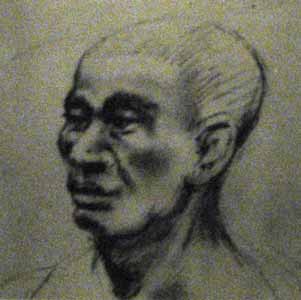
Khnum-Nakht
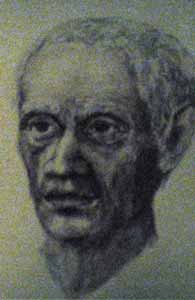
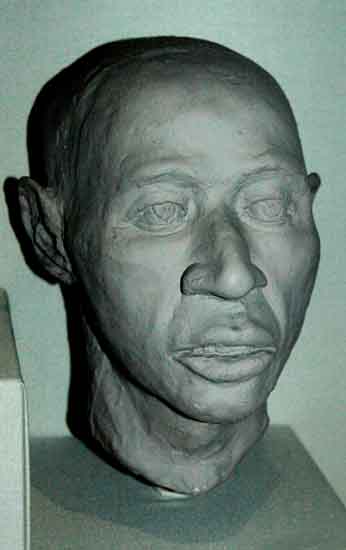
Khnum-Nakht
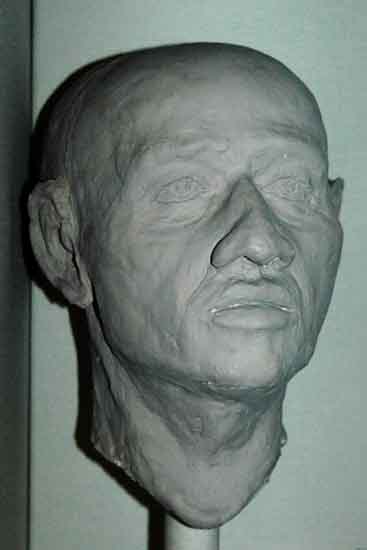
Nekht-Ankh
Facial Reconstruction
The reconstruction of the heads of Nekht-Ankh and Khnum-Nakht was undertaken to enable the skeletal remains to be related more easily to the brothers as they may have appeared during their lives.
The skull is the matrix upon which the head and face we built. If the shape of the soft tissue can be rebuilt on a skull, the result will be a reconstruction which the proportion and position of the main, features will be accurate. By utilising measurements of soft issue thickness, as established by Kollman end Buchly in 1898, the features of these two mummies were built up in clay on casts of the skull.
Nevertheless the details of certain areas - nose. mouth and ears - are open to speculation. Both Nekht-Ankh and Khnum-Nakht showed a marked similarity to the two small wooden statuettes, which were found in the tomb.
The objective was to produce pictures using the clay busts as models. A sketch of Khnum-Nakht (left) was made - he would seem to have been a man with strong features all somewhat Negroid in appearance. The other shows Nekht-Ankh (right) as an older man of about 60 years (it is known that he had short grey hair). His features are weaker than his bother with less well-defined features.
This slight variation in the inscriptions, taken in conjunction with the men's marked anatomical differences, may indicate that their mother had two husbands, and that the father of Khnum-Nakht possessed Nubian ancestry. During much of Egypt's history, there was a certain mingling of the peoples of Nubia with those of Egypt at all levels of society. However, it is accepted nowadays that a child may well inherit a marked similarity to one of his parents while having no resemblance at all to the other. This could well be the case with the two brothers, and one had the usual appearance of an Egyptian while the other had inherited the characteristic Nubian features.
Another possibility, and equally likely explanation of this difference in appearance, is that Nekht-Ankh was adopted into the family at a very early age, and having been a member of it for so many years, had become accepted as the son of Aa-Khnumu. Future DNA studies on samples of tissues or bone taken from these bodies may provide an answer to the question of their relationship. Professor Rosalie David (OBE, FRSA, Professor of Biomedical Egyptology at the University of Manchester) confirmed in Nov-2004 that work is being pursued on the Two Brothers but no DNA studies have yet been undertaken.

Khnum-Nakht


Khnum-Nakht

Nekht-Ankh
Facial Reconstruction
The reconstruction of the heads of Nekht-Ankh and Khnum-Nakht was undertaken to enable the skeletal remains to be related more easily to the brothers as they may have appeared during their lives.
The skull is the matrix upon which the head and face we built. If the shape of the soft tissue can be rebuilt on a skull, the result will be a reconstruction which the proportion and position of the main, features will be accurate. By utilising measurements of soft issue thickness, as established by Kollman end Buchly in 1898, the features of these two mummies were built up in clay on casts of the skull.
Nevertheless the details of certain areas - nose. mouth and ears - are open to speculation. Both Nekht-Ankh and Khnum-Nakht showed a marked similarity to the two small wooden statuettes, which were found in the tomb.
The objective was to produce pictures using the clay busts as models. A sketch of Khnum-Nakht (left) was made - he would seem to have been a man with strong features all somewhat Negroid in appearance. The other shows Nekht-Ankh (right) as an older man of about 60 years (it is known that he had short grey hair). His features are weaker than his bother with less well-defined features.
Translation and Transliteration
Body Coffins
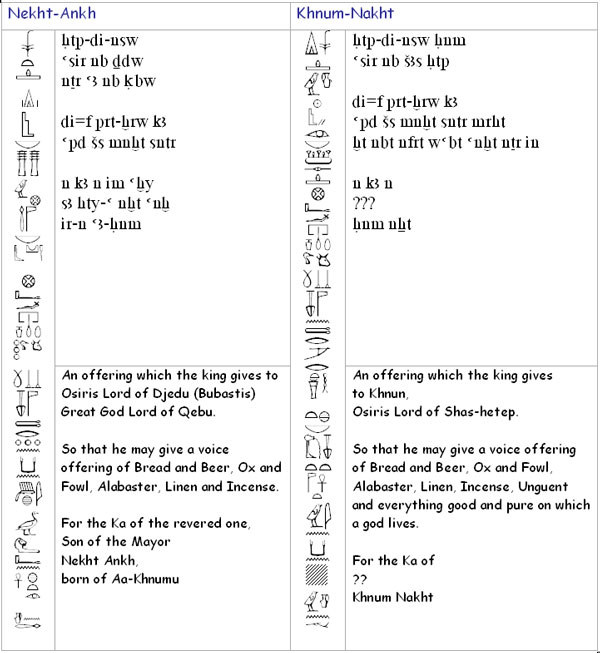
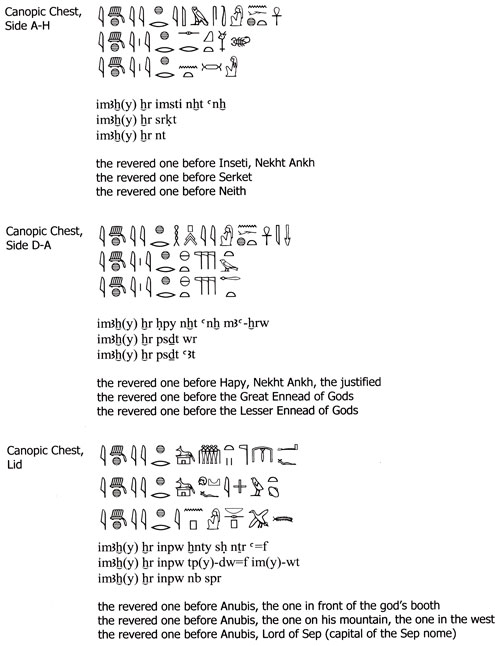
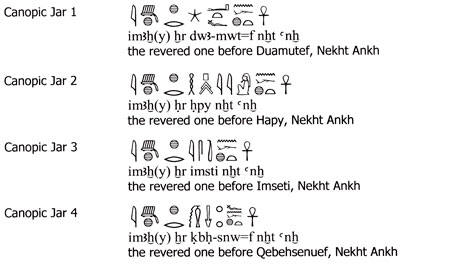
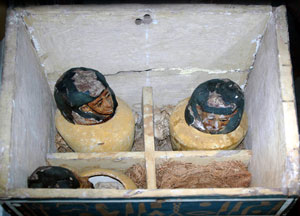
la tumba de Khnum-Nakht y Nekht-Ankh es un ejemplo de como consiguieron ser enterrados juntos y posiblemente mantener una relación entre ellos.

Fuente de la foto egiptologia. comDejo una foto de la tumba de estos dos personajes

Body Coffins




la tumba de Khnum-Nakht y Nekht-Ankh es un ejemplo de como consiguieron ser enterrados juntos y posiblemente mantener una relación entre ellos.

Fuente de la foto egiptologia. com

No hay comentarios:
Publicar un comentario